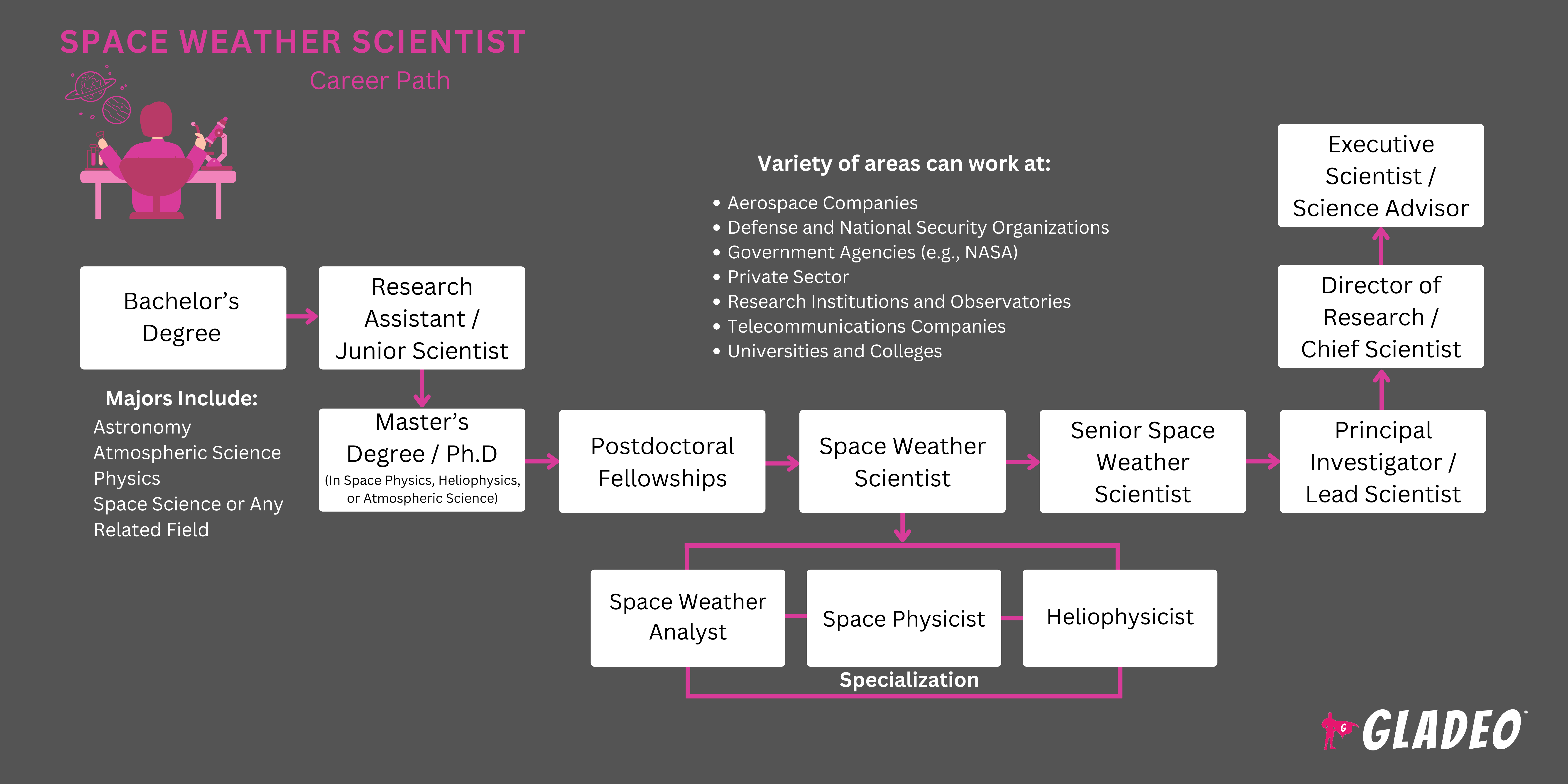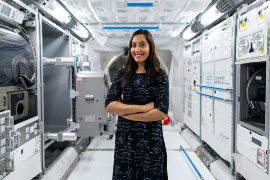Mga spotlight
Solar Physicist, Space Physicist, Heliophysicist, Astrophysicist (Solar & Space Physics), Atmospheric and Space Scientist Geomagnetist, Ionospheric Scientist, Plasma Physicist, Aeronomist (focuses on the upper atmosphere), Space Environment Researcher, Space Systems Scientist, Magnetospheric Physicist
From our viewpoint on Earth, the Sun doesn’t look that big. But if it was hollow, you could stuff ~1.3 million Earth-sized planets inside it!
The Sun isn’t just big; it’s a giant flaming ball of plasma that constantly emits energy and charged particles into space. This solar activity, known as space weather, can be highly disruptive to our modern communication systems, power grids, and satellite operations. That’s why we need Space Weather Scientists to study the Sun’s effects on Earth's magnetosphere, ionosphere, and atmosphere.
Space Weather Scientist jobs include space weather analysts, space physicists, and heliophysicists. Their job descriptions vary, but in general, they all analyze solar flares, coronal mass ejections, and geomagnetic storms to predict their effects and develop strategies to protect technology and infrastructure.
By monitoring the Sun in real-time and improving space weather forecasting models, Space Weather Scientists help safeguard astronauts, satellites, power grids, and navigation systems from potentially damaging solar activity. Thus, their work is crucial in our increasingly space-reliant world!
- Protecting critical infrastructure from solar-induced disruptions
- Advancing scientific understanding of solar and geomagnetic activity
- Working with space agencies, research institutions, and government organizations
- Contributing to space exploration and astronaut safety
Oras ng trabaho
Space Weather Scientists typically work full-time, with some positions requiring on-call monitoring during heightened solar activity. They work in observatories, research facilities, space agencies, and universities.
Mga Karaniwang Tungkulin
Space Weather Scientist is a general term that includes space weather analysts, space physicists, and heliophysicists. While their roles overlap, each specialization has distinct focuses within space weather research and forecasting. Here’s a breakdown of their typical duties!
Space Weather Analyst - Focuses on real-time monitoring and forecasting of space weather events. Often works in operational environments like the National Oceanic and Atmospheric Administration’s Space Weather Prediction Center or military and aerospace organizations.
- Monitor solar activity using ground- and space-based telescopes, satellites, and magnetometers in real time.
- Issue space weather alerts and forecasts for aviation, satellite operators, power grids, and communication networks.
- Analyze real-time data from solar and magnetospheric instruments to predict geomagnetic storms and radiation hazards.
- Assist government agencies and commercial industries in preparing for space weather impacts on infrastructure.
- Maintain databases of past space weather events and assess their long-term trends.
Space Physicist - Studies the physical processes of the Sun, solar wind, and Earth’s magnetosphere. Works in research labs, academia, or with space agencies.
- Develop and refine space weather models to improve forecasting of geomagnetic storms.
- Study interactions between the Sun and Earth’s upper atmosphere, ionosphere, and magnetic field.
- Use spectroscopy, radio wave analysis, and remote sensing to study solar emissions and their impact on space weather.
- Conduct theoretical and computational research on plasma physics, magnetic reconnection, and charged particle dynamics.
- Analyze space-based and ground-based observations to improve understanding of space weather phenomena.
Heliophysicist - Specializes in studying the Sun and its influence on the heliosphere, including solar cycles, flares, and coronal mass ejections (CMEs). Often collaborates with observatories and space agencies.
- Investigate the mechanisms behind solar flares, CMEs, and the solar wind to understand their causes and effects.
- Develop models to simulate solar activity and its impact on space weather.
- Work with NASA, ESA, and other space agencies on solar observation missions like the Parker Solar Probe and Solar Orbiter.
- Study the Sun’s magnetic field evolution and how it drives space weather events.
- Contribute to the design of instruments for solar observation and heliophysics missions.
All three roles have certain cross-specialization responsibilities, such as:
- Collaborating with agencies like NASA, NOAA, and ESA to monitor space weather and issue alerts.
- Supporting aerospace and telecommunications industries in mitigating space weather risks.
- Assessing the effects of solar storms on GPS, radio signals, satellite communications, and power grids.
- Developing early-warning systems for space weather events.
- Working with AI and machine learning to process large datasets from space missions and ground observations.
Karagdagang Tungkulin
- Publish research findings and present at scientific conferences.
- Conduct public outreach and education on space weather hazards.
- Write grant proposals and secure research funding.
- Collaborate with international research institutions on space weather studies.
- Provide expert consultation to space agencies and satellite operators.
- Review scientific literature and stay up to date on solar and space weather developments.
- Train new researchers and graduate students.
Soft Skills
- Kakayahang umangkop
- Analitikal na pag-iisip
- Pansin sa detalye
- Komunikasyon
- Pagkausyoso
- Paggawa ng desisyon
- Focus
- Integridad
- Mga kasanayan sa organisasyon
- pasensya
- Pagtugon sa suliranin
- Pagtutulungan ng magkakasama
- Pamamahala ng oras
Teknikal na kasanayan
Space Weather Scientists need hard skills related to the following:
- Solar observation techniques, including radio, X-ray, and ultraviolet imaging
- Spectroscopy and magnetometry for analyzing solar activity
Data analysis software (e.g., Python, MATLAB, IDL, GIS, SPENVIS) - Space weather modeling and simulation techniques
- Remote sensing technologies for monitoring the Sun and ionosphere
- AI and machine learning for processing space weather data
- Computational fluid dynamics for studying plasma physics
- Satellite instrumentation and telemetry analysis
- Electromagnetic wave propagation modeling
- Space mission planning and orbital mechanics fundamentals
- Government agencies (e.g., NASA)
- Research institutions and observatories
- Universities and colleges
- Mga kumpanya ng aerospace
- Mga kumpanya ng telekomunikasyon
- Defense and national security organizations
Working as a Space Weather Scientist can be demanding, particularly when handling urgent alerts that may affect global communications, aviation, or energy infrastructure. Since solar activity is unpredictable, they must be prepared for equally unpredictable work schedules. Their research requires constant monitoring, often in high-stakes environments where precise forecasting is essential to protecting satellites, spacecraft, and power grids.
Because the field spans multiple disciplines – including astrophysics, atmospheric science, and data science – staying current with research and advancing technologies requires a strong commitment to continuous learning!
As our reliance on space-based technology grows, so does the urgency to understand and predict space weather! That’s why the race is on to build the next generation of tools that will keep us protected from the Sun’s unpredictable outbursts.
AI and machine learning are making forecasts more accurate and timely by processing massive amounts of solar data in real time, spotting patterns to predict potential geomagnetic storms. Meanwhile, international partnerships are growing, as space agencies around the world team up to study solar activity.
Missions like NASA’s Parker Solar Probe and the ESA’s Solar Orbiter are pushing deeper into space, capturing unprecedented data on solar winds and coronal mass ejections. Back home on Earth, Space Weather Scientists are developing advanced early-warning systems that can alert power grids, airlines, and satellite operators to incoming solar storms, helping them minimize disruptions. Private aerospace companies are also doing their part, as they recognize that space weather resilience is crucial for satellites and future crewed missions beyond Earth’s orbit.
Space Weather Scientists often had a deep curiosity about space and natural phenomena. Many were fascinated by astronomy, physics, and computer science. They may have enjoyed stargazing, building electronic circuits, participating in science fairs, or coding simulations.
- Space Weather Scientists need at least a bachelor’s degree in a major such as physics, atmospheric science, astronomy, space science, or a related field.
- Most roles require a master’s or Ph.D. in space physics, heliophysics, or atmospheric science.
- Postdoctoral fellowships (such as those at NASA’s Heliophysics Division, NOAA’s Space Weather Prediction Center, ESA, or major universities) are important for advanced or specialized training.
- Ang mga karaniwang kurso sa kolehiyo ay kinabibilangan ng:
- Astrophysics
- Atmospheric science
- Data science and programming
- Electromagnetic theory
- Numerical modeling
- Plasma physics
- Remote sensing
- Space physics
- Space Weather Scientists need to develop practical skills using a range of scientific instruments, data analysis software, and computational modeling techniques. Internships and research assistantships are crucial for building this experience.
- Relevant data analysis software includes Python (for data processing and machine learning), MATLAB (for numerical simulations), IDL (for space physics analysis), and GIS/SPENVIS (for geospatial and space environment simulations).
- Since space weather science is interdisciplinary, students want to pursue certifications in AI, machine learning, spectroscopy, plasma physics, remote sensing, computational fluid dynamics, or geospatial data analysis to enhance their expertise.
- Additional training and certifications include:
- Look for accredited programs in space physics or heliophysics.
- Find programs that feature:
- Partnerships with space agencies or national research labs,
- Research opportunities in space weather and solar studies, and,
- Access to observatories and space weather monitoring labs and tools.
- Check out faculty bios to learn about their expertise in space weather studies and current research.
- Review scholarships, financial aid, and research funding opportunities.
- Compare tuition and fees, including in-state vs. out-of-state costs.
Space Weather Scientists have many online resources to help them find suitable programs, such as:
- American Meteorological Society’s list of degree programs, internships, and fellowships
- GradSchoolShopper - Heliophysics and Space Weather Programs
- National Weather Association - Colleges & Universities
- Niche - 2025 Best Colleges for Physics
- Niche - 2025 Best Colleges with Atmospheric Sciences and Meteorology Degrees
- Top Universities - QS World University Rankings – Physics & Astronomy 2024
- U.S. News & World Report - Best Global Universities for Space Science
- U.S. News & World Report - Best Physics Schools
- U.S. News & World Report - Colleges Offering a Meteorology Major
- In high school, take advanced courses in physics, calculus, and computer science to prepare for college.
- Participate in astronomy clubs or research projects. Join research projects, open-source collaborations, or internships related to space weather.
- Develop skills using data analysis tools such as Python, MATLAB, or R.
- Follow updates about space missions and research on space weather topics. Some organizations to keep up with include:
- NASA – Operates space weather monitoring missions like the Solar Dynamics Observatory and Parker Solar Probe to study the Sun’s activity and its effects on Earth.
- NOAA – Runs the Space Weather Prediction Center providing forecasts and warnings for solar storms that could impact Earth’s technology and infrastructure.
- ESA (European Space Agency) – Conducts space weather research through missions like Solar Orbiter; maintains the Space Weather Office for monitoring solar activity.
- US Air Force & US Space Force – Monitors space weather for national security and military satellite operations; ensures communication and navigation systems remain operational.
- National Science Foundation (NSF) – Funds research on solar-terrestrial interactions; supports ground-based observatories like the Daniel K. Inouye Solar Telescope.
- Lockheed Martin – Develops space weather observation instruments, including those used on GOES satellites, which track solar storms.
- Boeing – Provides satellite technology for space weather monitoring; helps design spacecraft that withstand solar radiation.
- Northrop Grumman – Works on space weather-related defense projects; supports heliophysics research through collaborations with NASA and NOAA.
- SpaceX – Designs and launches satellites affected by space weather, such as Starlink, which must mitigate the risks of solar storms and geomagnetic activity.
- Rocket Lab – Launches small satellites for space weather research; supports projects studying Earth’s magnetosphere.
- Sierra Space – Develops space habitats like Dream Chaser, requiring protection from radiation and space weather effects.
- Axiom Space – Plans commercial space station modules designed to withstand space weather conditions in low-Earth orbit.
- Relativity Space – Advances 3D-printed spacecraft for future space weather observation missions.
- Maxar Technologies – Builds space weather monitoring instruments and satellites for NOAA and NASA to study solar emissions and geomagnetic activity.
- Ball Aerospace – Develops instruments for missions like NASA’s Solar and Heliospheric Observatory and the upcoming Geospace Dynamics Constellation.
- The Aerospace Corporation – Conducts research on space weather impacts for national security, satellite communications, and human spaceflight.
- Attend space science conferences and engage with professionals in the field.
- Seek mentorship from scientists working in space weather-related careers.
- Ask to do an informal interview with a working Space Weather Scientist! Read books and blogs (like SpaceWeather.com), and watch videos (like those found at Space Weather News).
- Keep track of work and academic accomplishments for your resume and/or college applications.

- Search job portals like Indeed, USAJobs, IEEE, and the websites of any employer you want to work for, in case they don’t advertise on job portals!
- Look for any job openings, internships, or even postdoctoral positions at NASA, NOAA, private companies, or research institutions.
- Pay attention to the keywords in the job ads, and incorporate them into your resume, as applicable. For example:
- Computational fluid dynamics
- Coronal mass ejections (CMEs)
- Electromagnetic wave propagation
- Exospheric modeling
- Geomagnetic storms
- GPS signal disruptions
- Heliophysics
- Ionosphere
- Magnetohydrodynamics (MHD) models
- Magnetometry
- Orbital mechanics
- Plasma physics
- Power grid protection
- Radiation belt modeling
- Satellite data processing
- Solar flares
- Solar wind analysis
- Spectroscopy
- SPENVIS
- Check out Space Scientist resume templates for ideas. Customize your resume and cover letter for each application, clearly linking your skills to the job description.
- Network with people who work for organizations like NASA or NOAA. Ask them to let you know about upcoming job opportunities.
- Hilingin sa mga dating propesor at superbisor na magsulat ng mga liham ng rekomendasyon o humiling ng kanilang pahintulot na ilista ang mga ito bilang mga sanggunian.
- Make a profile on LinkedIn and other networking platforms to advertise your availability.
- Prepare for interviews by reviewing the employer’s mission and values. Brush up on your terminology and recent space weather research and missions.
- Read sample interview questions such as “How do solar storms and geomagnetic activity impact critical infrastructure, such as power grids and communication systems, and what mitigation strategies do you recommend?” or “Can you describe a time when you analyzed space weather data to predict a significant event? What tools and models did you use, and what was the outcome?”
- Sanayin ang iyong mga tugon sa pamamagitan ng mga kunwaring panayam .
- Magsuot ng angkop para sa mga panayam sa trabaho !
- Let your supervisor know you’re interested in career advancement.
- If you don’t yet have a graduate degree, get one!
- Stay updated with new observation techniques, space weather modeling advancements, and AI-driven data analysis.
- Learn to use increasingly advanced laboratory equipment, computational modeling tools, and planetary simulation software.
- Earn advanced certifications in heliophysics, computational modeling, planetary science, or remote sensing.
- Publish research findings in peer-reviewed journals like Space Weather and present at major conferences.
- Gain leadership experience by mentoring students, leading lab teams, or assisting in academic programs.
- Build relationships with senior scientists and seek mentorship for career development.
- Join professional organizations like the American Geophysical
Union, the Space Weather Prediction Center, the Solar Physics Division of the American Astronomical Society, and the International Space Weather Initiative to stay updated on research, collaborate with experts, and access career development resources. - Gain proficiency in grant writing to secure funding for long-term research initiatives. Apply for grants to fund independent projects.
- Collaborate with international researchers on space weather missions, planetary habitability studies, and laboratory experiments.
- Tackle specialized research areas like spectroscopy, biosignature detection, or astrochemistry.
- Publish research findings and seek leadership roles in research teams, space weather centers, or space agency projects.
- Seek positions with increasing responsibility, such as principal investigator roles, mission scientist positions, or leadership in space agency research teams.
- Participate in workshops, webinars, and industry events to stay informed and expand professional networks.
Mga website
- American Geophysical Union
- Boeing
- Daniel K. Inouye Solar Telescope
- European Space Weather Office
- Geospace Dynamics Constellation
- GOES (Geostationary Operational Environmental Satellites)
- International Space Weather Initiative
- Lockheed Martin
- NASA Heliophysics Division
- National Oceanic at Atmospheric Administration
- National Science Foundation
- National Solar Observatory
- NOAA Space Weather Prediction Center
- Northrop Grumman
- Parker Solar Probe
- Solar and Heliospheric Observatory
- Solar Dynamics Observatory
- Solar Orbiter
- Solar Physics Division of the American Astronomical Society
- SpaceWeather.com
- SpaceX
- Ang Aerospace Corporation
- United States Air Force
- United States Space Force
Mga libro
- Introduction to Space Weather, by Mark Moldwin
- Machine Learning Techniques for Space Weather, by Enrico Camporeale, Simon Wing, et al.
- Space Weather: Physics and Effects, by Volker Bothmer and Ioannis Daglis
- The Sun’s Influence on Climate, by Joanna Haigh and Peter Cargill
Space Weather Scientists play a crucial role in monitoring and predicting space weather events, but if this career isn’t the right fit for you, there are many other related paths to explore. Below are some alternative careers to consider!
- Aerospace Engineer
- Agricultural Meteorologist
- Air Quality Scientist
- Atmospheric Chemist
- Aviation Meteorologist
- Climate Scientist
- Climatologist
- Data Scientist
- Energy Meteorologist
- Siyentipiko sa Kapaligiran
- Geophysicist
- GIS Analyst
- Hydrologist
- Meteorologist
- Oceanographer
- Planetary Scientist
- Remote Sensing Specialist
- Satellite Engineer
- Space Physicist
- Space Weather Scientist
- Storm Chaser
- Weather Risk Analyst
Mag-click dito upang i-download ang infographic
Newsfeed

Mga Tampok na Trabaho

Mga Online na Kurso at Tool








